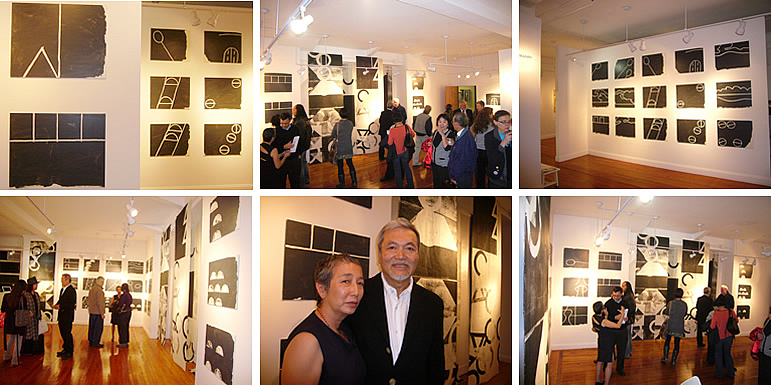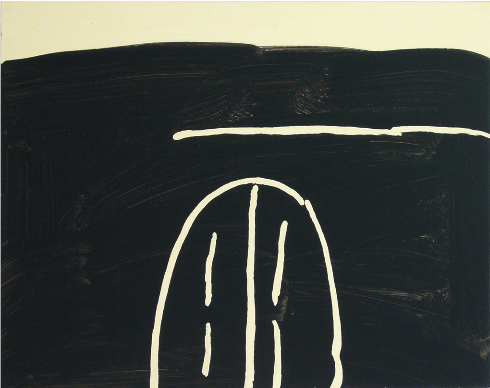This is to announce the gHitoshi Nakazato Exhibition: Hiroshima Revisited| Black Rain.h NY Coo Gallery reopened on Broadway in August 2009 and it is the first one-person show at the new location with an effort to hold meaningful shows as the gallery journeys forward.
The works entitled gBlack Rainh came about from the profound and intense emotion that Mr. Nakazato experienced on his second visit to Hiroshima, which also triggered the prospect of exploring unchartered territories in modernist vocabulary resulting in the 60 black and white works.
This series was first shown in gHiroshima Revisited: An Exploration in Transcending Modernismh this past summer at the Pageant Gallery in Philadelphia receiving favorable reviews. It was a show originally intended to open on the evening of the August 6th Hiroshima Peace Memorial Ceremony at a gallery near the epicenter. The show was cancelled by the sponsor of the gallery, a real estate developer, due to the sub-prime loan debacle in the U.S. affecting the world financial situation. Fortunately, the show was held in Philadelphia with its opening on July 3, the day before Independence Day, proved meaningful.
Mr. Nakazato is a graduate of Tama Art University in Tokyo in oil painting, worked as an art reporter for the Hokkaido Times, received his MS from the University of Wisconsin, and MFA from the University of Pennsylvania, Graduate School of Fine Arts, recipient of the John D. Rockefeller III Foundation Grant, has continuing his art work in New York and Tokyo since 1966. He has shown throughout Japan including in open-person shows at the Tokyo Gallery and Muramatsu Gallery, and Hara Museum of Contemporary, Tokyo.
This first one-person show in the renewed gallery space promises to meet expectations with a quality of excellence. We await your visit.
NY Coo Gallery
uBlack Rain Series II v
There was a period in which I believed that all expressions from the traditional to contemporary aesthetic issues could be contained within simply drawn lines and painted fields on canvas. There was a period in which to attract more viewers of these Minimalistfs works, partial framing was attached as quotation marks on the edge of the canvases, or horizontally elongated canvases were intentionally used. There was a period in which diptychs - two canvases - were attached to obtain the effect of juxtaposition and eclectic tension. There was a period in which circle, triangle, and square of Sengai (1750-1835) were used as painterly vocabulary for the Line Outside (written sengai as a homonym in Japanese) series, in an attempt to reach beyond the known. There was a period in which Monad, the philosophy from the Greeks to early 14th century were used as a metaphor for the painterly process.
These are the footprints in my Modernist search and exploration for my own realm of expression. My studio attitude was to avoid focusing on personal matters, in my attempt to reach the Modernistfs pinnacle as the flag bearer of the avant-garde.
Ten years ago, due to a request from a museum to reduce shipping expense, I started to work on large-format paper, which resulted with a series of works, 30 inches in width and 35 feet in horizontal length. In this same series, there are two sets of paintings with same width but 50 meters long with one consecutively drawn 400-meter line. The initial reason to reduce expense became irrelevant and the works became so large that their entirety could not be view in my studio.
I questioned what subconscious reasons there were for these over-sized works. Then, it came to mind in a flash. Hidden underneath many layers of memory was the backyard of a traditional indigo dye shop, my motherfs home, with stretched dyed material for kimonos, and myself running through the rows in search of my mother. My avant-garde work intersected with my oldest visual memory of almost 70 year ago. The discovery that there was an original-scape, which existed beneath my new works brought tears to my eyes and moved me most deeply.
It was after this experience that I revisited Hiroshima, and read the letters that were exchanged among U.S. Government officials and researchers involved with the manufacturing and testing of the A-bomb at the Hiroshima Peace Museum which caused me be taken aback. I accept the offer of a one-person show that would open on August 6th of this year, the day of the Peace Memorial Service. Juxtaposing my own war and post-war experience, anti-nuclear weapons stance as the subject for my studio work was inevitable.
Picassofs monochromatic Guernica was envisaged, and with the aim to create a black and white series, it began as a process of painting images that came to mind on small panels. I received a critique calling them gframes from a movie film.h The series to celebrate the new century in 2001 which was continued despite 9/11 and the ambivalence I felt about the role of art in society became the Black Rain Series.
Hitoshi Nakazato
September 11, 2009
********** NY Coo Gallery News Letter - September **********
Our current exhibition is "Hitoshi Nakazato - Hiroshima Revisited, Black Rain" consisting of 45
black and white paintings on panels and 5 monoprints that hang from the ceiling down
to the floor which create a specific space. These paintings despite the title "Black Rain" and its cry
against nuclear proliferation celebrate the human spirit with its positive message of love.
The human ability to imagine shows us the way toward a better future.
Please visit our gallery and experience it yourself.
The exhibition runs through September 29th. 
|


